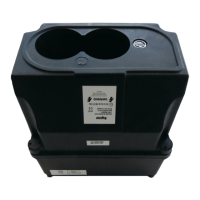3. Functional Description
3.1 Initialisation
When the detector is switched on the LED indicator flashes briefly to signify power-up. During the first 10-seconds the detector
performs auto-calibration to establish the quiescent obscuration level.
Note:
It is important that the beam path is cleared to a healthy state (no obscuration) prior to resetting the detector. If the beam path is
not healthy the detector will recalibrate to the current level of obscuration and may well report false alarm/fault conditions as the
path clears. If obscuration is high (dirty lenses or smoke/oil mist present) then the detector will not be able to establish an
operational state and will report a Clean fault (Clean LED pulses ON for 4 seconds) or a Life fault (Life LED is illuminated
continuously). The PUIM will latch the fault condition and the Detector/P-UIM will require resetting once the beam path is clear.
3.2 Alarm Level Detection
The detector monitors the obscuration level within the beam path and when it detects a loss of 0.5 dB it latches a low-level alarm
condition. If the loss is maintained within the 0.5 to < 1.5 dB band during the subsequent 15-second alarm condition monitoring
period, a low level alarm will then be reported (detector LED pulses ON/OFF for 30 seconds). If the loss exceeds 1.5 dB then a high
level alarm is latched and this status will be reported (detector LED pulses ON/OFF for 2 minutes) at the earliest at 8-seconds from
the beginning of the alarm condition monitoring period. If the high level occurs subsequent to the initial 8 seconds of the alarm
condition monitoring period and before a total of 15 seconds has elapsed, the high level alarm will be latched and reported
immediately.
It should be noted that if the level of loss during the alarm condition monitoring period falls below 0.5 dB. The latched alarm level
will be reset and the detector continues to monitor.
3.3 Beam Blocked
If the level of obscuration increases suddenly to a high level of loss a beam-blocked status will be latched and if the level is
maintained for 60 seconds, Beam Blocked will be reported (detector LED flashes ON for 2-seconds). If the beam-blocked level of
obscuration clears for more than a few seconds during the 1-minute beam-blocked condition-monitoring period, the detector
returns to its normal operating state.
3.4 Dual Automatic Compensation
The Detector automatically compensates for gradual detector lens contamination and also compensates for the more rapid
environmental changes (e.g. temperature change). The detector will report a CLEAN fault (detector LED flashes ON for 4 seconds)
once. If the detector is not cleaned it will continue to operate until a LIFE fault is detected (detector LED ON steady) at which point
the detector latches to an OFF condition. The detector must be cleaned and the reset once the LIFE fault has been detected.
3 / 12

